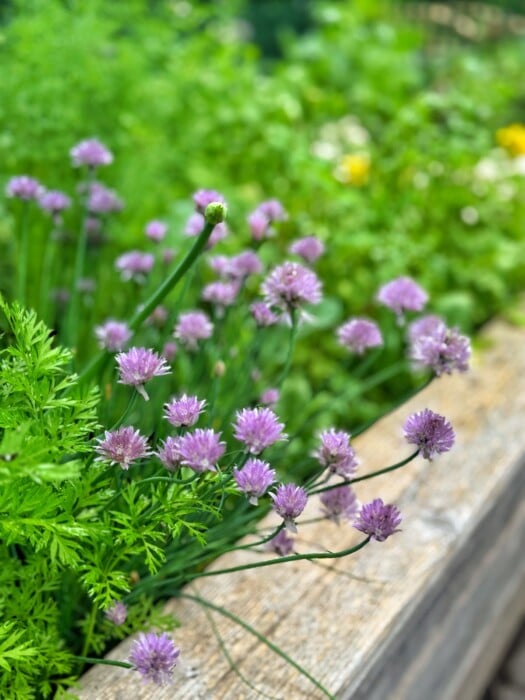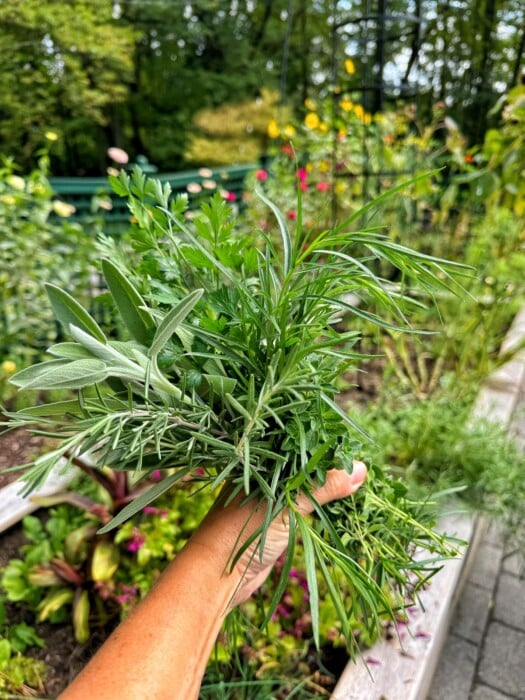Grow bigger, brighter zinnias! Discover 15 essential companion plants for a thriving garden. Learn what you need and how they benefit your blooms now!
Zinnias, with their bright, beautiful blooms and easy-going nature, are a favorite among flower enthusiasts. But did you know you can level up your zinnia patch to a whole new level by incorporating companion plants for both the aesthetic and natural pest control?
Companion planting involves strategically placing specific plants near each other to create a mutually beneficial relationship. Not only can companion planting improve the health and beauty of your zinnias, but it can also attract helpful insects and deter pests too.
Here are 15 easy companion planting ideas for zinnias!
(Posts on stacyling.com may contain affiliate links. Click HERE for full disclosure.)

Best Beneficial Insect-Attracting Plants for Zinnias: Companion Planting Guide
Zinnias aren’t just beautiful; they’re also a magnet for beneficial insects. To attract more of these helpful garden allies, consider planting herbs like:
- dill
- fennel
- parsley
- thyme.
The fragrant foliage of these plants attracts hoverflies, ladybugs, and parasitic wasps, all of which help keep pest populations in check.
Flowers like cosmos and alyssum also make excellent companions. Their cheerful blooms not only add visual interest to your zinnia bed, but they also attract pollinators like bees and butterflies. These busy insects flit from flower to flower, inadvertently helping to control pest populations while ensuring good pollination for your zinnias.

Natural Pest Control: Companion Plants for Zinnias
Certain companion plants act as natural deterrents to common garden pests. Marigolds, with their strong scent, are renowned for repelling nematodes, whiteflies, and some beetles. Nasturtiums and calendula (pot marigold) can act as a trap crop, attracting aphids away from your beloved zinnias, essentially sacrificing themselves for the greater good!
Last year, my calendula and borage served as amazing companion plantings for my cut flower garden as they lured all the aphids away from my dahlias, zinnias, strawflowers, and other cutting flowers.
Pre-Bloom Companion Plants to Enhance Your Zinnia Garden Before Flowering
Since I garden in zone 6b and start my zinnias from seed, they don’t generally bloom until July making my flower garden look pretty boring until they do. Because of this, it’s a great idea to have other flowering annuals and perennials planted around them to add more color to your borders as they mature.
Because can we all agree that more blooms will make your garden that much prettier BEFORE your zinnias begin to flower? Consider some of the following ideas as base plants for your zinnia flowers that will add both color and interest to flower beds.
15 Essential Companion Plants for Thriving Zinnias
While choosing companion plants for your zinnias, remember to consider plant height and sun requirements. Taller companions like sunflowers can provide vertical interest and keep your zinnia blooms more upright when planted near them, but you’ve got to make sure they don’t cast excessive shade on your sun-loving zinnias. Similarly, choosing plants with similar sunlight and soil needs ensures both companions thrive.
Here are 10 perfect plant partners that will help your zinnia garden thrive.
Dill (Foeniculum vulgare)
Dill plant thrives in full sun and appreciates well-drained, fertile soil. This feathery herb isn’t just for cooking as it attracts hoverflies, ladybugs, and parasitic wasps which are like nature’s pest control team that keep your zinnias safe from bad insects like aphids.
Not to mention, itts delicate foliage adds a textural contrast to the bolder blooms of zinnias, creating a visually interesting bed. In my garden, I allow my dill to go to seed every year because it looks pretty and helps attract the beneficials and pollinators, including butterfly caterpillars. Isn’t it so pretty?


Parsley (Petroselinum crispum)
Parsley is a multi-tasking marvel in the garden. Not only can you harvest its fragrant leaves for culinary dishes, but it also makes a fantastic companion plant for zinnias. This herb tolerates both full sun and partial shade, but thrives in moist, well-drained soil. Similar to dill, parsley attracts hoverflies and parasitic wasps keeping your zinnias safe from harmful insects.
Beyond its practical benefits, parsley offers a touch of visual interest. Its green foliage provides a nice contrast to the vibrant blooms of zinnias, adding another layer of textured green to your garden.
While it may attract some butterfly caterpillars, rest assured that these are unlikely to cause significant damage to your parsley plants, and their presence can actually be an indicator of a healthy ecosystem in your garden.

Calendula (Calendula officinalis)
Calendula brings sunshine and a helping hand to your zinnia bed. This cheerful bloomer thrives in full sun with well-drained soil. But calendula’s benefits extend beyond its sunny disposition. It attracts ladybugs, hoverflies, and other beneficial predators, creating a natural pest patrol that keeps unwanted visitors away from your zinnias.
Calendula is super easy to start from seed too! Choose from the winter sowing method or simply sow them directly outdoors once all danger of frost has passed.
Their bright blooms not only add pops of color and interest around your zinnias, but also extend the blooming season, offering a gorgeous display from summer well into fall.

Cosmos (Cosmos bipinnatus)
Cosmos bring a touch of cottage garden whimsy to your zinnia bed, perfectly complementing the bolder blooms with their airy grace. These sun loving flowers thrive in well-drained soil. Beyond their appearance, cosmos acts as a magnet for bees, butterflies, and other pollinators.
This ensures optimal pollination for your zinnias, guaranteeing bountiful blooms throughout the season. And for those who appreciate visual interest, the light and airy foliage of cosmos adds a touch of texture to zinnia borders, creating a truly stunning combination.

Marigold (Tagetes spp.)
Marigold thrives in full sun and prefers well-drained soil while boasting bright blooms that create a captivating color combination alongside your zinnias. But marigolds offer more than just visual appeal; their strong scent acts as a natural pest deterrent, repelling nematodes, whiteflies, and some beetles, keeping your zinnias safe from harm.
Marigolds are also fantastic for filling in around the base of your zinnia plants while they’re still maturing seedlings. This adds a bright pop of color to your flower bed early in the season, creating a visually stunning display from the very beginning before your zinnia flowers even bloom!
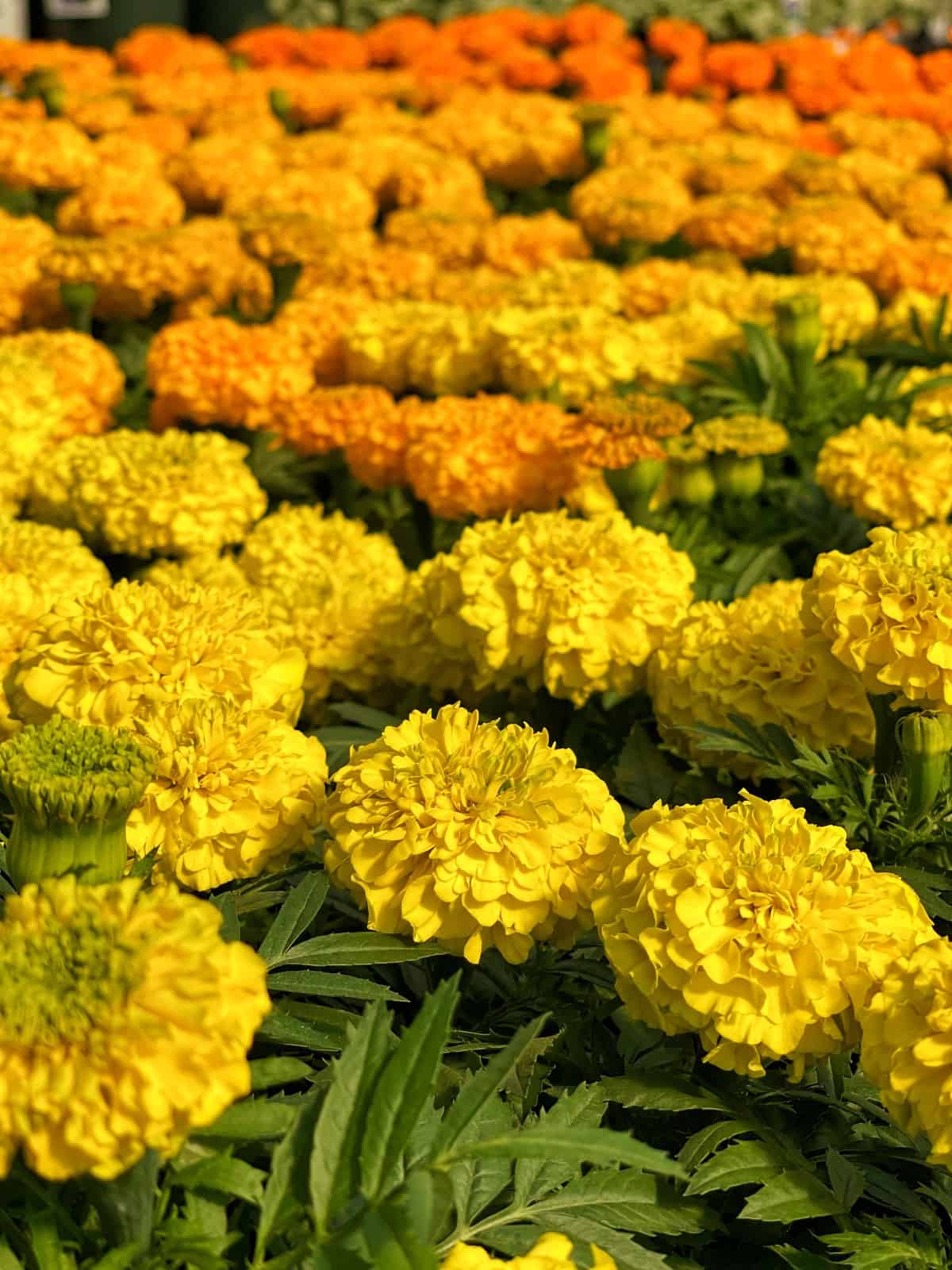
Nasturtium (Tropaeolum majus)
Nasturtiums bring a unique twist to your zinnia bed. Adaptable to both full sun and partial shade, they thrive in well-drained soil. These versatile plants act as a trap crop that attracts aphids away from your zinnias. This selfless sacrifice protects your zinnias while adding a touch of the unexpected with their vibrant edible flowers and leaves.
I usually grow mine at the base of my zinnia plants in raised garden beds and the trailing varieties spill over while softening the edges of the garden.
And they’re incredibly easy to start from seed too! Simply wait until all danger of frost has passed, then sow the seeds directly into beds. Germination is quick! I’ve found that nasturtiums thrive with direct sowing, eliminating the need for starting them indoors.


Sunflower (Helianthus annuus)
Sunflowers are serious workhorses for attracting pollinators! Bees and butterflies flock to these cheerful blooms, benefiting your zinnias in turn. Sunflowers thrive in sunny locations with well-drained soil. However, their impressive height can be a double-edged sword.
While dwarf varieties are ideal for companion planting, taller sunflowers can actually provide support for your zinnias to help keep them from toppling over. The key is strategic placement: ensure the sunflowers don’t cast excessive shade on your zinnias, allowing them to bask in the full sun they crave.


Borage (Borago officinalis)
Borage is a multi-talented companion plant for zinnias, offering a visual treat and a helping hand. This beautiful annual tolerates both full sun and partial shade, while thriving in well-drained soil. Borage attracts pollinators like bees, ensuring a continuous stream of visitors to your zinnias throughout the summer.
But its benefits don’t stop there; borage also improves soil fertility, creating a win-win situation for your zinnias. Last year, my borage was planted immediately next to zinnias and they helped draw aphids away from the blooms.
Imagine a stunning display of gorgeous zinnia blooms set against the beautiful blue edible flowers of borage. This charming combination adds a touch of elegance and cottage style to your garden while creating a captivating contrast of colors.

Sweet Alyssum (Lobularia maritime)
Sweet Alyssum is a low-growing annual thrives in full sun with well-drained soil and loves to fill in those empty spots around the base of your taller zinnias. But its benefits go beyond aesthetics.
Sweet alyssum attracts hoverflies and other beneficial insects, adding another layer of protection for your zinnias from harmful pests.
Plus, its sweet fragrance and cascading habit create a delightful addition to your flower bed. Imagine a soft, fragrant cloud concealing the base of your zinnias while adding a burst of color, especially during those early stages when seedlings are still maturing and not flowering. Sweet alyssum effectively bridges the gap, ensuring a visually stunning display from the very beginning of the season.
If I were growing zinnias in pots, I would make them the thriller plant and surround them with sweet alyssum so they add color to the base of plants and spill over the edges of the containers.

Petunias (Petunia x hybrida)
With varieties tolerating both full sun and partial shade, petunias can fill in gaps while adapting to your garden’s layout. Moist, well-drained soil is ideal. These long-blooming companions are more than just pretty faces; they attract pollinators like bees and butterflies, ensuring a steady stream of visitors to your zinnias throughout the summer.
The vibrant colors of petunias create a visually stunning display alongside your zinnias, especially during the early stages when zinnia seedlings are still maturing and not flowering. Petunias effectively bridge the gap with their established blooms, creating a captivating flower bed from the very beginning of the season.


Nepeta (Catmint)
Nepeta, commonly known as catmint, is a fantastic companion for zinnias, offering a wealth of benefits. Its delicate, often lavender-purple spires of flowers attract a wide array of beneficial pollinators, including bees and butterflies, which will further enhance the pollination of your zinnias.
While not a strong pest repellent, its presence can contribute to a more diverse and healthy garden ecosystem, indirectly deterring some common garden pests. A major advantage of nepeta is its excellent deer resistance, making it a reliable choice for areas where deer are a concern. And they are an issue in my garden so planting nepeta around my zinnias has helped!
Visually, nepeta provides a soft, airy contrast to the bolder forms and vibrant colors of zinnias. Its long-lasting blooms and silvery-green foliage create a beautiful, billowy base that complements the upright structure of zinnias, adding a sense of natural grace and a cool color palette that can highlight warmer zinnia hues.
I love planting zinnias around my nepeta because this perennial plant conceals the early growth while there’s no color and adds texture to my cutting garden.
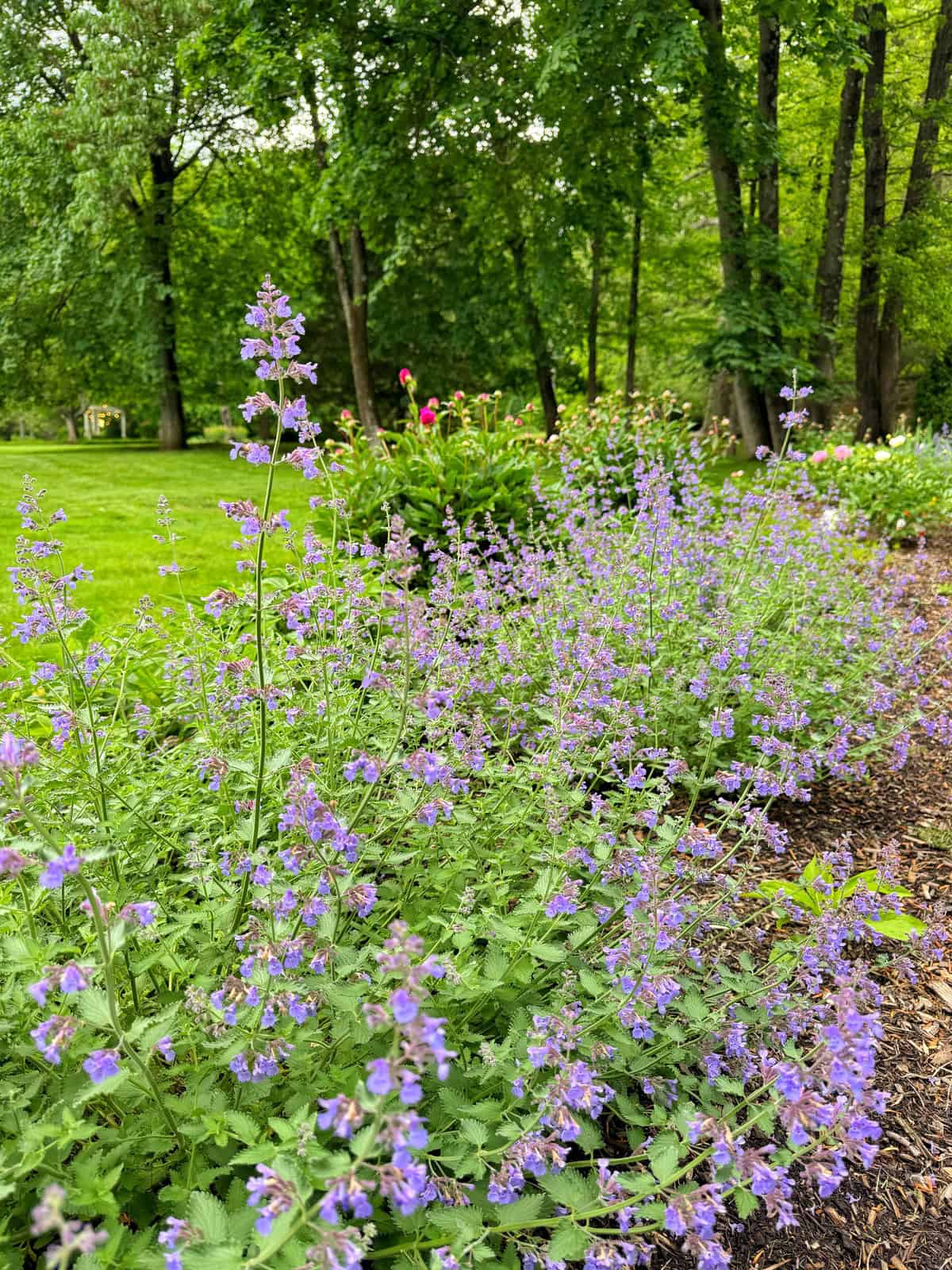
Lavender
Lavender is a classic companion plant, and for good reason. Its fragrant flowers are a magnet for essential pollinators like bees, butterflies, and even some beneficial hoverflies, all of which will assist in the pollination of your zinnia blooms.
Beyond its beauty, lavender is renowned for its pest-repelling properties; its strong aromatic oils are known to deter various garden pests, including aphids and whiteflies, which can sometimes plague zinnias.
Deer typically avoid lavender due to its pungent scent, making it an excellent deer-resistant choice. Aesthetically, lavender’s stately, upright flower spikes and silvery-green foliage provide a sophisticated textural and color contrast to zinnias. The soothing purple hues of lavender can create a serene backdrop for the cheerful exuberance of zinnias, adding a touch of elegance and an incredible fragrance to your garden space.
I plant zinnias around my lavender plants in the potager and it looks so pretty when it’s all in bloom.

Rosemary
Rosemary is more than just a culinary herb; it’s a valuable companion for zinnias. While its flowers are small, they are attractive to bees and other small beneficial insects, contributing to overall garden health. Rosemary is particularly effective as a pest deterrent; its potent aroma is known to repel a range of common garden pests, including carrot rust flies and cabbage moths, and can indirectly help protect your zinnias from general insect pressure.
Like many aromatic herbs, rosemary is highly deer resistant. Visually, rosemary offers a distinctive evergreen presence with its needle-like foliage and often upright, woody growth habit. This provides a structural anchor and a different texture that beautifully contrasts with the broad leaves and softer petals of zinnias. The deep green of rosemary can also make the vibrant colors of your zinnias pop, adding an element of timeless beauty to your garden design with an aromatic touch.

Oregano
Oregano is a powerhouse of a companion plant, offering numerous benefits to your zinnia patch. Its small, often white or pinkish flowers are highly attractive to a diverse array of pollinators, including bees, butterflies, and beneficial predatory insects such as hoverflies and parasitic wasps, all of which help maintain a balanced garden ecosystem.
The strong scent of oregano can also help confuse and deter common garden pests. Oregano is generally considered deer resistant, as its aromatic foliage is unappealing to them.
From a visual standpoint, oregano provides a lush, mounding form that can create a beautiful groundcover around the base of your zinnias. Its soft green foliage and delicate blooms offer a textural contrast, and when allowed to flower, it adds a subtle beauty that enhances the overall natural appeal of your zinnia planting, providing a relaxed and informal charm.
I love the billowy blooms of oregano when planted around the base of my zinnia plants. It adds that cottage garden touch with the buzz of pollinators.

Salvia
Salvia, a diverse genus, offers an incredible range of companion options for zinnias. Many salvia varieties are absolute magnets for pollinators, particularly hummingbirds, bees, and butterflies, drawn to their tubular flowers rich in nectar. This makes them excellent partners for boosting the overall pollinator activity in your zinnia garden.
While some varieties may have mild pest-repelling qualities, their primary benefit lies in attracting beneficial insects that can help control pest populations naturally. Most salvia varieties are also known for their good deer resistance.
Visually, salvia brings a strong vertical element and a rich spectrum of colors, from vibrant blues and purples to fiery reds and soft pinks, which can beautifully complement or contrast with the broad color palette of zinnias. The varied forms, from slender spikes to more substantial flower clusters, add dynamic interest and structure, making your zinnia garden appear more layered, sophisticated, and continuously blooming.
I am a HUGE fan of growing salvia in my gardens and have several varieties. Because they are long blooming, they add that cottage garden look to your zinnia garden.
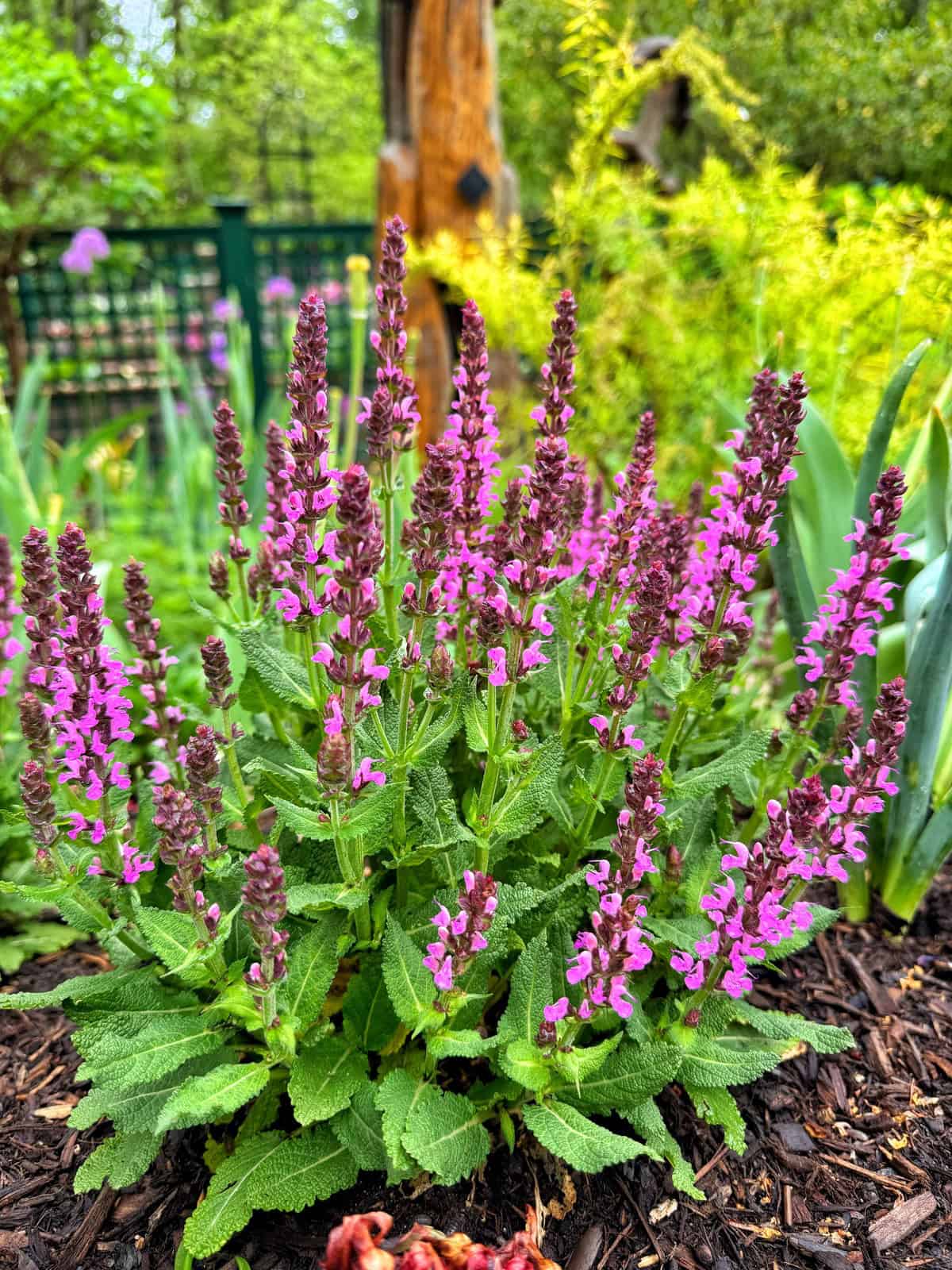
Effective Companion Plants to Deter Deer from Zinnias
If deer are a problem around your flower beds, there are a few companion planting ideas you can try to help keep them away and will look GORGEOUS around your zinnias too. Here are a few deer resistant flowers that can help keep deer from eating your blooms.
- Lavender
- Nepeta
- Russian Sage
- Globe Thistle
- Snapdragons
- Rosemary
- Sage
- Thyme
- Oregano
- Larkspur
- Peonies
- Bearded Iris
- Allium
- Agastache
- Salvia

Key Tips for Successful Blooming in Companion Planting with Zinnias
For a flourishing zinnia companion planting experience, here are some helpful tips:
- Plan your garden layout beforehand. Sketch out your design, considering plant heights and spacing needs. Think taller plants in the back and shorter plants in the front.
- Research planting times for each companion. Some plants may need to be started indoors before transplanting outdoors with your zinnias. Adding summer flowering annuals will add lots of color around the base of zinnias from the outset until the first frost.
- Maintain proper spacing between plants. Overcrowding can stifle growth and hinder air circulation causing powdery mildew and other problems with your zinnias and other flowers.
- Water and fertilize according to individual plant needs. Different plants have varying water and nutrient requirements. Plant like plants together so they are grouped based on light and soil needs.

Maximizing Your Garden’s Potential with Companion Planting for Zinnias
Companion planting with zinnias is less a strict science and more a joyful experiment. While these 10 ideas are a great starting point, remember that your garden’s microclimate is unique. I’ve found what works wonders in my yard might need a tweak in yours. So, trust your instincts, try different combinations, and see what truly makes your zinnia garden thrive. There’s no better way to learn than by getting your hands dirty and discovering the perfect companions for your garden.
To learn more about companion planting in home gardens, please read this article from the University of Minnesota Cooperative Extension.
Do you use companion plants in your garden to help your plants thrive? I’d love to hear what plants work for you. Let’s chat more in the comments below!
For more information about growing zinnias, read these informative articles that I wrote!
- The Best Way to Start Zinnia Seeds For Your Cut Flower Garden
- How to Grow Zinnias: Best Tips for Beginners
- Must-Have Zinnia Varieties for Your Cutting Garden
- Grow Better Zinnias: 15 Companion Plants You Need to Grow
- How to Beat Japanese Beetles on Zinnias
To drill down on more beginner gardening techniques and tips, please read these posts:
- Flower Gardening 101
- Growing a Cut Flower Garden for Beginners
- Container Garden Ideas for Beginners
- How to Start a Vegetable Garden
- Herb Gardening for Beginners
Thank you so much for following along.
Enjoy a beautiful day! xo

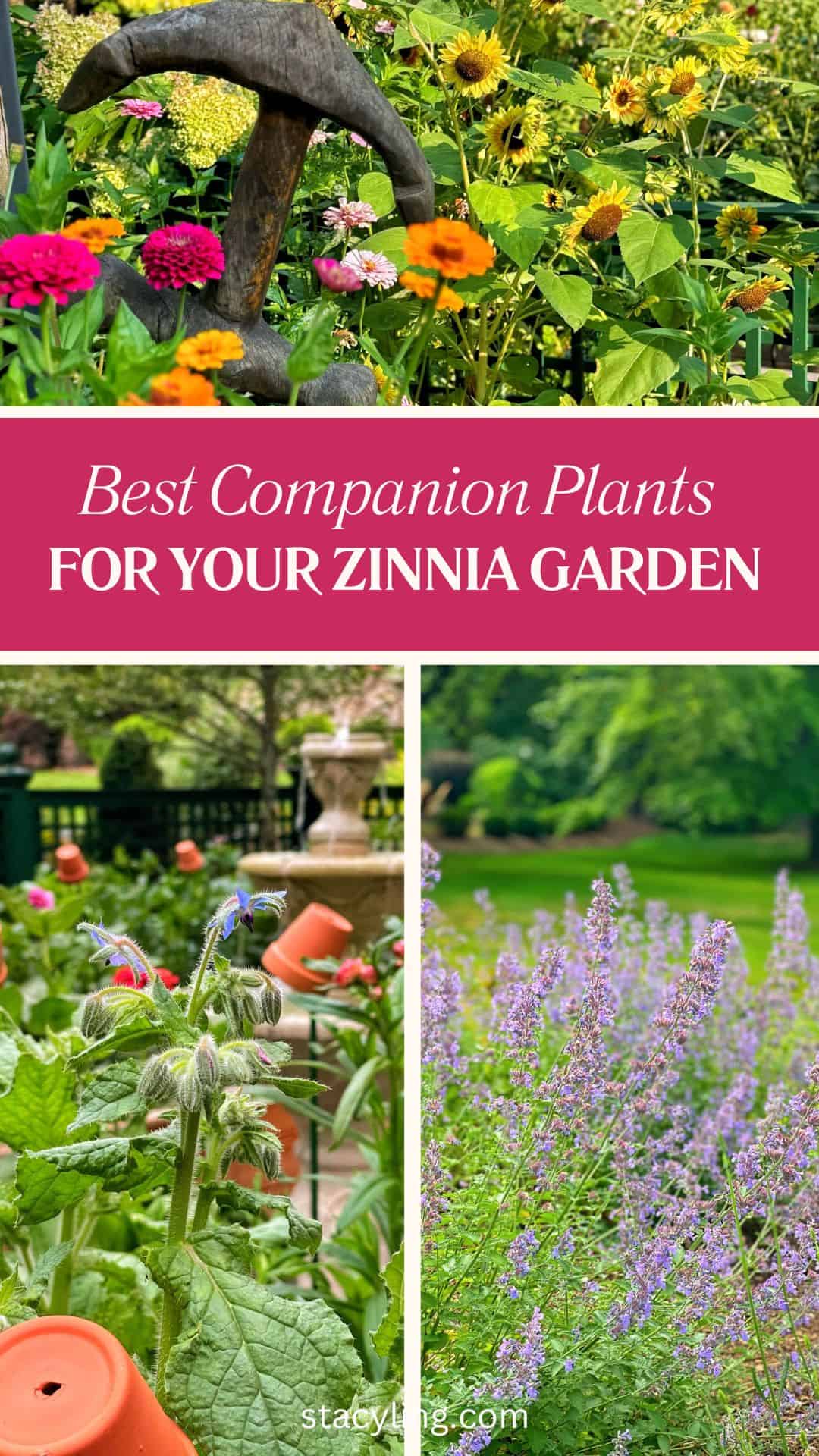

More Companion Planting Ideas For Your Garden
- Best Companion Planting Herbs: Grow a Healthier, Pest-Free Garden
- 10 Easy-Care Companion Plant Partner Ideas for the Vegetable Garden
- Companion Planting For Hostas




